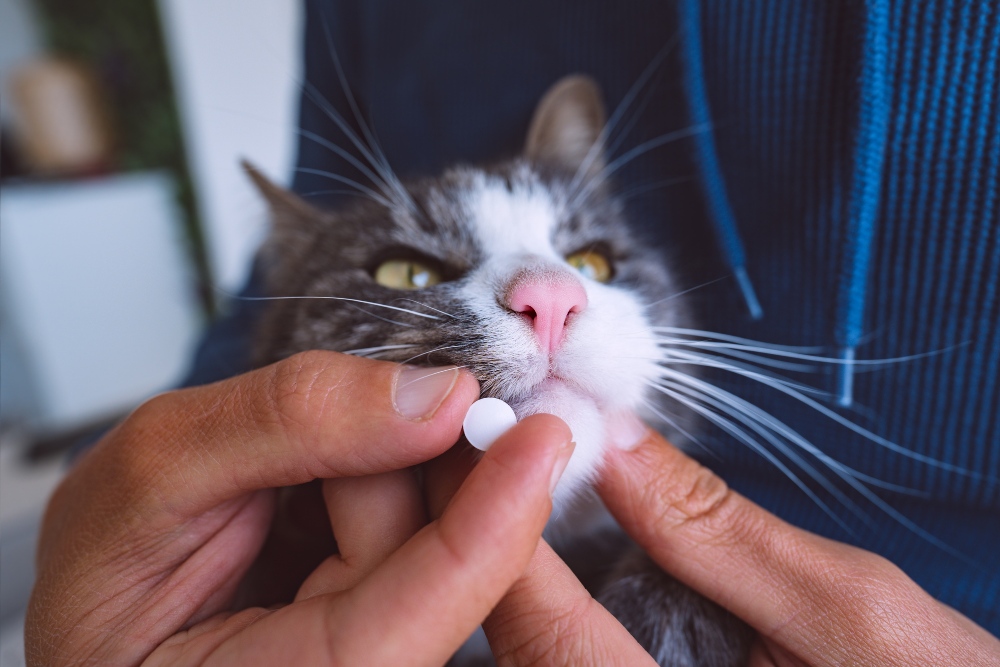Table of Contents
You have just returned home from a visit to the veterinarian’s office, and your vet has prescribed pills for your dog or cat. If you’re like most pet owners, you are probably eager to begin your pet’s treatment, but a little bit concerned about how you are going to get these pills into your pet.
Read on to learn some helpful strategies for medicating dogs and cats.
The Easiest Option: Camouflage the Pill
In many cases, you can easily sneak a pill into a tasty treat. You might choose to hide your dog’s pill inside cream cheese or peanut butter, while a cat might respond better to a pill hidden in canned food or tuna. You can even purchase Pill Pockets®, which are soft treats that are specifically designed to hide pills.
When selecting a treat, be sure to pick something your pet truly loves. You want them to ingest the whole treat in one big bite, instead of spending a lot of time chewing or investigating. The treat should also be a bit “sticky,” to make it harder for your pet to pick the pill out of the treat.
Slightly More Advanced: A Pill “Sandwich”
In some cases, a sneaky dog or cat may find the pill hiding inside their treat. Not only will this lead them to eat around the pill, it may make them more cautious in taking future treats from you! If this happens, you will need to be more deliberate in your pill-hiding efforts.
To minimize the chances of your pet finding the pill, try the following:
- First, give your pet a treat that does not contain a pill. Your pet may look for the pill, but they will probably eat the treat after not finding any pills inside. Repeat this a few times, until your pet is readily eating your treats without concern.
- Next, give your pet the treat that contains the pill. Hopefully, they will scarf it down after deciding that your treats are “safe!”
- Finally, give your pet a final treat without a pill, followed by praise and affection.
The goal is to do all of this relatively quickly, “sandwiching” the pill-containing treat between two unadulterated treats. This minimizes the likelihood of your pet discovering the treat inside the middle treat.
Expert Level: Pilling a Dog or Cat
If you can’t convince your dog or cat to take their pill in a treat, you are going to need to place the pill in their mouth. Fortunately, this is often easier than it sounds! However, it’s important to take your pet’s personality into account. If your pet has shown signs of aggression in the past, this could be an especially risky maneuver. Talk to your veterinarian if you are concerned about your ability to safely pill your pet.
How to Pill a Dog
- Wait for a time when your dog is in a good mood and interested in interacting, such as right before a meal.
- Hold your dog’s head by placing the thumb and forefinger of your non-dominant hand on either side of your dog’s upper muzzle.
- Use your other hand to gently open your dog’s lower jaw.
- Use your index finger or a pill popper to quickly position the pill as far back in your dog’s mouth as possible.
- Close your dog’s mouth and hold it closed briefly.
- Encourage your dog to swallow by rubbing their neck or blowing gently on your dog’s nose.
- Release your dog’s muzzle once they swallow the pill.
- Reward your dog with their meal, a high-value treat, or affection.
How to Pill a Cat
- Place your cat on a countertop or other elevated surface, for ease of handling.
- Position yourself behind your cat (with their tail up against your belly), to keep them from backing away from you.
- Place the thumb and forefinger of your non-dominant hand on either side of your cat’s upper muzzle, near the cheeks.
- Use your other hand to gently open your cat’s lower jaw.
- Use your index finger or a pill popper to quickly position the pill as far back in your cat’s mouth as possible.
- Close your cat’s mouth and hold it closed briefly.
- Encourage your cat to swallow by gently rubbing their neck.
- Release your cat’s muzzle once they swallow the pill. It can be difficult to feel when a cat has swallowed, but they often visibly lick their lips after swallowing.
- Reward your cat with a meal or a high-value treat.
Regardless of whether you are pilling a dog or cat, it is important to remain calm. Your pets can sense your anxiety and that will make the process more difficult. Additionally, prepare yourself to pill your pet as quickly as possible. The more time you spend getting into position, the more impatient your pet will become. Finally, use a treat or food reward to make the experience more positive, increasing your likelihood of success when administering the next dose of medication.
Additional Tricks
If you are struggling with the above tips, there are several additional strategies that you can try.
You may be able to crush a pill or open a capsule, then mix the powdered medication with a canned food or other soft treat. This doesn’t always work, because some medications have an extremely bitter taste that is difficult to mask, but it may be a consideration if more conventional strategies don’t work for you. Talk to your veterinarian before attempting this strategy, because some medications should not be crushed or opened.
If worse comes to worse and you still cannot administer the medication, contact your veterinarian. They may be able to offer an in-person demonstration of how to pill your pet, helping you modify your approach.
Finally, if your pet absolutely refuses to take pills, talk to your veterinarian to determine whether your pet can receive a chewable or liquid medication. Your veterinarian may be able to prescribe an alternative medication that is available in a different form, or may direct you to a compounding pharmacy that can customize your pet’s medication.
Remember, your veterinarian is just as concerned as you are with making sure that your pet receives their medication. Partnering with your veterinarian is a valuable strategy for medicating your pet.








